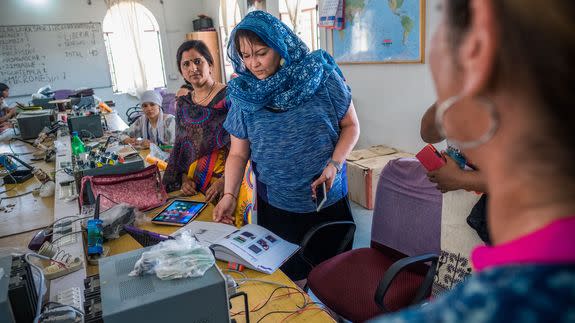That time Apple's Lisa Jackson met India's 'solar mamas'

It happened to be one of the hottest days ever recorded in Rajasthan, with the mercury touching 123 degrees Fahrenheit. While most of the media followed Apple CEO Tim Cook's every move as he met India's business tycoons, political leaders and Bollywood superstars in Mumbai, Lisa Jackson, former EPA chief and now Apple's vice president of environment, policy and social initiatives, quietly sneaked off to Rajasthan.
SEE ALSO: Apple doubles down on India
Some 66 miles away from Jaipur (about a two-hour drive) lies a tiny village called Tilonia. The otherwise nondescript, sleepy village of approximately 7,500 residents is of great interest to Jackson, who had flown thousands of miles to meet the world famous "solar mamas."

Image: Sephi bergerson
Tilonia is home to the Barefoot College, which was set up by Sanjit 'Bunker' Roy to train illiterate women from remote areas across the world to become solar engineers. The women stay in the village for six months, where they are trained to assemble, install and repair solar panels and lights. They come from villages that have no electricity and, by extension, no light once the sun sets. Barefoot College does not award any formal degrees or certificates but does ensure once these women go back to their villages, they can earn a living and improve the living conditions of the entire village.
Over a course of six months, the future solar engineers are trained to make the motherboard that is required to power the solar panel as well as instal and repair the panels themselves. With the students being illiterate, the teaching method relies on muscle memory. "Learning by doing, doing by learning" is a mantra one can hear the teachers repeating throughout the day.
Apart from women from Indian villages, Barefoot College trains women from African, Asian and Latin American countries into becoming solar engineers for their villages that are still off the grid. "I met women from Nigeria, Columbia and other countries. It was almost like a mini UN," Jackson says.
"I think the most striking moment was when one women stood up and said, 'It's just so remarkable because those things means so much,'" Jackson recounts. For one woman, it meant she could cook at night. Another could now use the otherwise unproductive hours of darkness to sew, which meant additional income for the household.
Jackson's curiosity about solar mamas is understandable. Apple, in its quest to use 100% renewable energy, is heavily invested in solar energy to power its facilities across the world. In Singapore, Apple is powering its facilities with a 32-megawatt solar project that has installed solar panels on more than 800 rooftops across the city. In China, it has installed 170 megawatts of solar energy to offset some of the energy used to manufacture its products.
"At Apple we have a commitment to leave the world a better place than how we found it. As a company we are now focused on energy efficiency and renewable energy to fight climate change. We are committed to moving to 100% renewable energy; that includes all our offices, retail stores and data centers. We are generating or sourcing 100% renewable energy in the U.S., and 93% globally," Jackson says. "But there is a lot more to do and lot more to learn but it's something we take wherever we go," she adds.
In 2010, Roy was named in Time magazine's top 100 most influential people in the world. In 2012, a documentary on Solar Mamas was released.
Images: Sephi Bergerson traveled with Apple's Lisa Jackson to document the solar mamas.

 Yahoo News
Yahoo News 